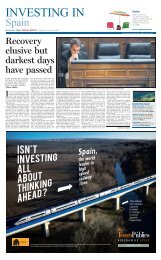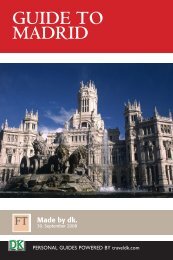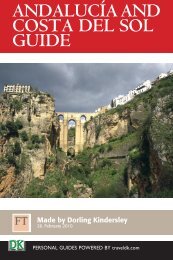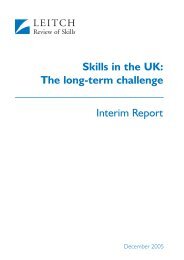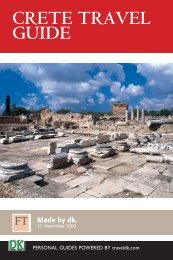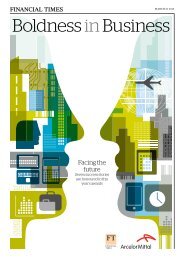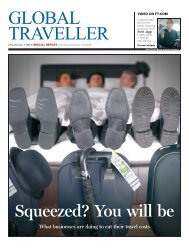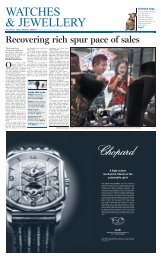Create successful ePaper yourself
Turn your PDF publications into a flip-book with our unique Google optimized e-Paper software.
Berlin Travel Guide<br />
Schloss Charlottenburg<br />
The construction of Schloss Charlottenburg, designed as a summer residence for Sophie Charlotte, wife of the<br />
Elector Friedrich III, began in 1695. Between 1701 and 1713 Johann Friedrich Eosander added a cupola and the<br />
Orangerie was extended. Today, it has been extensively renovated.<br />
Schloss Charlottenburg: www.spsg.de<br />
For more on Charlottenburg (see Charlottenburg & Spandau)<br />
Top 10 Sights<br />
1<br />
Altes Schloss<br />
The Baroque tower of the oldest part of the palace<br />
(1695) by Johann Arnold Nering is crowned by Richard<br />
Scheibe’s golden statue of Fortuna.<br />
2 Porzellankabinett<br />
The small, exquisite mirrored gallery has been<br />
faithfully restored to its original glory. Valuable porcelain<br />
items from China and Japan are on display.<br />
3 Schlosskapelle<br />
The luxurious splendour of the palace chapel recalls<br />
the once magnificent interior design of the palace, before<br />
it was destroyed in World War II. But appearances can<br />
be deceptive: apart from the pulpit which is preserved<br />
in its original form, the entire chapel – including the king’s<br />
box – is a costly reconstruction.<br />
4<br />
Monument to the Great Elector<br />
The equestrian monument of Friedrich Wilhelm I is<br />
considered to be one of his most dignified portraits.<br />
Made in 1696–1703 by Andreas Schlüter, it originally<br />
stood on the Rathausbrücke, near the destroyed<br />
Stadtschloss.<br />
5<br />
Neuer Flügel<br />
Built between 1740 and 1747 by Georg Wenzeslaus<br />
von Knobelsdorff, the new wing contains Frederick the<br />
Great’s private quarters.<br />
6 Schlosspark<br />
The palace park, originally Baroque in style, was<br />
redesigned by Peter Joseph Lenné between 1818 and<br />
1828 as an English-style landscape garden.<br />
7 Belvedere<br />
Friedrich Wilhelm II liked to escape to the romantic<br />
Belvedere, a summer residence built in 1788 by Carl<br />
Gotthard Langhans, which served as a tea pavilion. Today<br />
it houses a collection of precious Berlin porcelain objects.<br />
8<br />
Neuer Pavillon<br />
This Italianate villa behind the palace, designed by<br />
Schinkel for Friedrich Wilhelm III in 1825, was inspired<br />
by the Villa Reale del Chiatamone in Naples. The pavilion<br />
clearly shows the Hohenzollern’s love of the Italian style.<br />
9 Mausoleum<br />
traveldk.com<br />
Slightly hidden, this Neo-Classical building by Schinkel,<br />
is the final resting place for Queen Luise and other<br />
Hohenzollerns.<br />
10<br />
Museum für Vor- und Frühgeschichte<br />
The museum displays archaeological finds from<br />
prehistory right up to the Middle Ages, including tools,<br />
ceramics and textiles. Also on display is part of the<br />
famous Priamus treasure excavated by Heinrich<br />
Schliemann in Troy, which comprises precious golden<br />
jewellery from antiquity.<br />
Palace Rooms<br />
1<br />
Goldene Galerie<br />
The festival salon in the Neuer Flügel, 42 m (138 ft)<br />
long, was designed, in the Rococo style, by G W von<br />
Knobelsdorff for Frederick the Great. The richly<br />
ornamented room has a cheerful appearance.<br />
2 Ahnengalerie<br />
The wooden panelling of the so-called oak gallery<br />
is carved with preciously gilded portraits of the<br />
Hohenzollern ancestors.<br />
3 Gris-de-Lin-Kammer<br />
This small chamber in Friedrich’s second palace<br />
apartment is decorated with paintings, including some<br />
by his favourite artist, Antoine Watteau. The room was<br />
named after its violet-coloured damask ( gris-de-linin<br />
French) wall coverings.<br />
4<br />
Schlafzimmer Königin Luise<br />
Queen Luise’s bedchamber, designed in 1810 by<br />
Karl Friedrich Schinkel, features the clear lines typical of<br />
the Neo-Classical style. The walls are clad in silk fabrics<br />
and wallpaper.<br />
5 Winterkammern<br />
Friedrich Wilhelm II’s early Neo-Classical rooms<br />
contain fine paintings, wall carpets and superb furniture<br />
of the time.<br />
6 Bibliothek<br />
Frederick the Great’s small library has outstanding<br />
elegant book cases and an unusual, light green colour<br />
scheme.<br />
7 Konzertkammer<br />
Furniture and gilded panelling in the concert hall<br />
have been faithfully recreated as during Frederick the<br />
9<br />
Highlights




